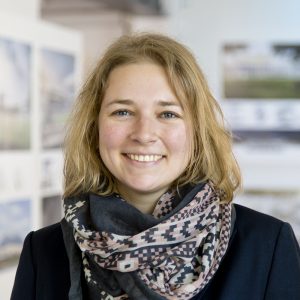
by Sara Mueller
Three years ago, the archives at Sasaki Associates, an architecture firm in Watertown, Massachusetts, did not exist. Today, archivist Aliza Leventhal works to ensure that the significance of this fledgling archive is seen throughout the firm.
A graduate of Smith College with degrees in Economics and American Studies, Leventhal earned her Masters in Library and Information Science at Simmons College in Boston, Massachusetts. Her passion for organizing historical records, garnered from working at the Institute for Women’s Policy Research, prompted Leventhal to concentrate her Simmons’ studies on the dual History and Archives program. During an internship at the Cambridge Historical Commission (CHC), Leventhal became “completely enamored with design records.”
Through her work with the CHC, Leventhal was drawn to the concept of what “physical environments do for collective memory and what documents do to support or corroborate or dispute that.” This idea has followed her into her current position as Archivist/Librarian at Sasaki, where Leventhal strives to bring together the firm’s belief in the connection between architecture and community and her own education in archives and preserving the past.
While Sasaki has had librarians in the past, Leventhal is the first trained archivist to step into the firm. The first to admit that there is no such thing as an average day, “things that are constantly happening is more like it,” Leventhal balances multiple tasks from providing resources for the architects such as periodicals as well as finding test prep resources, to what we perceive as the usual archival tasks of processing and arranging.
“Sasaki is unique as a firm to have an archivist,” Leventhal says, “there are only, probably, thirty-five or forty firms in the country that have archivists. But most of them have a donor agreement with an institution so the archivist is on staff for them because the institution is requiring the firm to process the collection before donating it.” Sasaki, however, isn’t donating their material anywhere, which allows Leventhal to focus on serving Sasaki instead of being pulled in different directions on archival standards. This uniqueness also helps cut down on the material stored by the archive, which, with about 7,000 projects and all their related material, would be a lot. Leventhal admits that it can sometimes be difficult to get material from project teams for the archives. “I basically have to hear rumblings that a project is about to be closed then I run to that project manager’s desk and say, ‘I hear you have stuff. Do you have stuff?’” While project managers are more likely than not to say no, that everything is digital, Leventhal knows that at least a few items are in physical form.
“The thing with designers and programmers and anyone who’s doing design for something active, current or for future, is that they are always future looking,” says Leventhal, “and they are very rarely past looking. There can be a lot of tension about talking about the past.” So how does Leventhal advocate for the archives?
Every other year, Leventhal curates an exhibit to help preserve the institutional memory of Sasaki. In addition, she helps to facilitate the orientation of new employees by letting them know that she is there whenever they need something. Leventhal has taken on what she terms her “personal call to arms” for Sasaki, which is to help facilitate knowledge management within the organization. Leventhal works to pair knowledge seekers with a “knowledge mentor,” someone who is an expert in the field who can then pass on what they know.
“It’s a concept of facilitating knowledge sharing and transfer,” says Leventhal. Surprised that she never learned this concept during her archival studies, Leventhal has embraced this philosophy and hopes to create a best practices manual to better facilitate the passing of knowledge.
While it can often be daunting to work as, what’s termed in the archive world, a lone arranger, Leventhal has found ways to bridge the gap between the business and archival worlds. Whether that be through learning to use the language of her organization instead of archival jargon or through the simple act of shortening her e-mails to quick business speak. She knows that she can, also, reach out to others in the library and archive world should she need.
No matter what, though, Leventhal has one major focus in her work at Sasaki: showing pride and teaching others to instill pride in their work. At the end of the day, if she has helped Sasaki to own more of its history, Leventhal feels that she has done her job.
